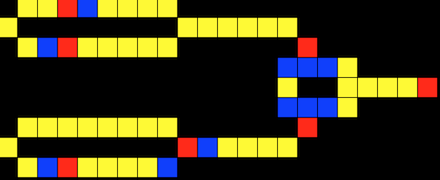Wireworld is a cellular automaton first proposed by Brian Silverman in 1987. It is particularly suited to simulating electronic logic elements, or "gates", and, despite the simplicity of the rules, Wireworld is Turing-complete.
This is a simple implementation in Python, with a basic GUI.
$ python ww.py source delay
Several samples are provided in the circuits folder. For example, an XOR gate with feeders with half second delay between each frame:
$ python ww.py circuits/xor-generators.txt 500
- Basic window sizing capabilities. The window and block sizes are computed within certain boundaries to accommodate the wireworld (no window resize though)
- Adjustable delay
engine.py: the automatongui.py: a Tkinter GUI
The project does not require any external dependencies.
From wikipedia: a Wireworld cell can be in one of four different states, usually numbered 0–3 in software, modeled by colors in the examples here:
Empty (Black)
Electron head (Blue)
Electron tail (Red)
Conductor (Yellow)
As in all cellular automata, time proceeds in discrete steps called generations (sometimes "gens" or "ticks"). Cells behave as follows:
Empty → Empty
Electron head → Electron tail
Electron tail → Conductor
Conductor → Electron head if exactly one or two of the neighbouring cells are electron heads, or remains Conductor otherwise.
This project is licensed under the terms of the GNU GPL v3 license. Full license text here.
